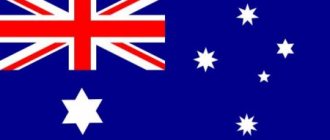Schooling is compulsory in Australia. Children must start going to school no later than 6 years of age. However, most children still start earlier, at the age of 4.5-5.5 years. The Australian school system differs slightly from state to state. For example, in the Australian Capital Territory and New South Wales, kindergarten is part of primary school, while in other states it is part of early childhood education. In some states, primary school ends in the 6th year and in some in the 7th year. But in general, the school system in Australia can be divided into three stages:
- Primary school - grades 0 - 6 (or 7 in several states).
- Secondary school - 7th (or
 10th grade.
10th grade. - Senior secondary school - 11th and 12th grades.
Photo source
Primary school
Children start attending primary school at the age of 5-6 years and finish it at the age of 12-13 years. In primary schools there is a strong emphasis on developing literacy, numeracy and social skills. The core subjects are English, reading and writing, mathematics, and social and environmental studies. Children also study music, art, computers, science and a foreign language. Students can also take part in numerous extracurricular activities such as sporting events, choral singing, orchestras, theater, etc.
Secondary school
The secondary school period runs from Years 7-8 to Year 10. The core subjects are English, Social Studies and Environment, Languages, Mathematics, Personal Development, Health and Physical Education, Science, Art and Technology. Subjects from these areas are compulsory, but students also have the opportunity to choose some electives. At this stage, children try out different fields to understand their inclinations and future specialization.
After 10th grade, students can leave school and continue their education through VET courses or go to work. However, in order to enter higher education institutions, students must complete grades 11 and 12 at school.
Senior secondary school
The high school curriculum is more specialized. Students continue to study English as a core subject and several other electives (at least three). Most schoolchildren choose their university preparation subjects based on the areas they want to study at university, such as maths and science, arts, humanities or business.
At the end of grade 12, students take exams and receive a certificate of completion of secondary education. Each state has its own name for the school leaving certificate, but all are recognized by Australian universities.
Features of Australian training programs
Studying at universities and colleges in Australia has its own nuances. The most important feature is the credit-module system - a kind of cumulative system for assessing knowledge.
The essence of this system is that students can transfer to another program of study without any examinations. To move on, they need to collect a minimum number of credits - points.
There are no entrance exams here either. The decision to admit an applicant is made after reviewing the package of documents.
For example, you enrolled in language courses at college. After completing them, you decide to start studying in a professional program, after which you can receive a first-degree certificate. And then you can work on getting the remaining second, third and fourth degree certificates. If you intend to study further, you must complete a program whose goal is to obtain a diploma and then a bachelor's degree. Moreover, you can always transfer (if you wish) to the 2nd or 3rd year of a partner university.
The bottom line is that a vocational program in college is a fairly advanced possible path to university study.
There are narrowly focused schools in Australia. For example, the School of Tourism and Hotel Management offers students a diploma program in cooperation with institutions in Switzerland. Having completed it, the student is awarded 2 diplomas (Australian and Swiss).
Such schools are focused on narrowly focused training of personnel for restaurants, hotels, and travel agencies. Australian schools generally aim to develop students' vocational skills that are based on a significant amount of practical training. At the same time, students undergo practical training in the same hotels (or other institutions corresponding to the chosen specialty). And for their work they are often paid a decent salary.
School infrastructure
Australian schools are among the best in the world. The infrastructure and technical equipment are always modern and diverse. Digital interactive whiteboards in classrooms, computer laboratories, wireless computer networks, libraries, science laboratories can be found in every Australian school. In addition to classes, children participate in extracurricular activities such as concerts, theater performances and excursions. For these purposes, schools also have music halls and musical instruments, theaters or concert halls.
Much attention is paid to sports in schools. Schools always provide excellent sports facilities such as various sports fields, courts, swimming pools and gyms.
In most Australian schools, children are required to wear a uniform. Each school has its own uniform design and colors.
For a comfortable learning environment and an individual approach to children, the number of students in a class is limited to 30.
If your child does not speak English well, this is not a problem. Schools have special teachers who conduct classes in English as a foreign language for foreign students. As a rule, children quickly adapt to the new language and soon begin to speak English.
The school must report on the child's progress at least twice a year. The report is provided to parents in writing and includes results in each subject, a report on other activities and comments on behaviour, personal development and attendance. There is also the opportunity to meet with each teacher at least twice a year. Meetings are always individual and last about 10 minutes.
Universities in Australia
The Group of Eight – Australia's eight oldest and most prestigious universities
Australian higher education is highly regarded in the Pacific region. And diplomas from this continent are valued all over the world.
Of course, most of all private and public educational institutions are located in the country's largest cities - Melbourne and Sydney.
The University of Sydney, the oldest university in Australia, was founded back in 1851. In addition to this, the following universities are considered prestigious:
- The Australian National University, ANU (category A);
- The University of New South Wales, UNSW (category A);
- The University of Melbourne (category A);
- The University of Queensland (category A);
- Monash University (category A);
- The University of Adelaide (category A);
- The University of Western Australia (category A);
- Curtin University of Technology (category B);
- Flinders University (category B);
- Macquarie University (category B);
- Queensland University of Technology (category B);
- Royal Melbourne Institute of Technology (category B);
- University of Technology Sydney (category B);
- University of Wollongong (category B);
- Bond University (category C);
- Deakin University (category C);
- Griffith University (category C);
- LaTroube University (category C);
- Murdoch University (category C);
- Newcastle University (category C);
- Swinburne University (category C);
- University of Tasmania (category C);
- University of South Australia (category C);
Where category A is five-star universities, category B is four-star, category C is three-star universities.
Every year, some universities in categories B and C change positions, but on average everything remains approximately the same.
The education system at the University of Australia is three-stage:
- Bachelor degree - basic higher education;
- Higher education - complete higher education;
- Master degree - postgraduate course.
To study for a bachelor's degree, you will have to spend 3-4 (Honours Degree) years. In some fields (medicine, dentistry, engineering), the period of study increases to 6 years.
Students can also take advantage of such a recently popular service as obtaining a “double degree” - obtaining 2 degrees at once in the fields of business and law or management and information technology. But double-level training will take longer.
If you have a bachelor's degree, a master's degree can be obtained in 1-2.5 years. There are 2 options for master's programs:
- Course Work is a standard program designed for attending lectures, practical classes, and passing tests.
- Research – this option is reminiscent of our graduate school with passing a minimum of disciplines, followed by writing a scientific paper.
The highest academic qualification is the degree of Doctor of Science (PhD), which is awarded only as a result of in-depth study of a theoretical course, as well as the writing of a research paper. Together with the research, the study will last about 3-4 years.
And these are the so-called Sandstone Universities - the six oldest universities in Australia
Knowledge assessment system
In Australia there are 2 knowledge assessment systems:
- Four-stage system - a system with grades of the following type: HD (High Distinction), D (Distinction), C (Credit), P (Pass). The last two points mean an unsatisfactory grade: CP (Conceded Pass), F (Fail)
- Alpha system - modeled on the American education system with knowledge grades A + , A , B , C , D.
If you find it difficult to understand and compare these two systems, we will give you a simple table to help you, with which everything will become much clearer:
| % correct answers | System 1 | System 2 |
| 85—100 | HD | A+ |
| 75—84 | D | A |
| 65—74 | C | B |
| 50—64 | P | C |
| 47—49 | C.P. | D |
| less than 47 | F | F |
University preparation
Whether it is simply an interest in Australian education or immigration to Australia through study, you will have to prepare intensively for admission.
Many foreign applicants are trained in Foundation courses. On average, studies there last about 44 weeks. However, if you are in a hurry, you can use the Fast-Track accelerated option. Often such quick courses are taken by those who want to study English and study several specialized subjects at the same time.
If you successfully complete the Foundation program, there is almost a 100% guarantee that you will be a happy first-year student.
Foundation Programs
Such programs are a kind of connecting link between domestic secondary education and Australian higher education. They are intended exclusively for international students, giving them the necessary knowledge and skills with which the student can easily adapt to local student life.
The program consists of 3 main areas:
- English language,
- special disciplines,
- Academic skills (the so-called acquisition of academic skills) is a special subject, the analogue of which does not exist in the Russian education system.
Studying English here is aimed at intensively preparing the student to successfully pass the international IELTS exam (which is at least 6.6 points). In addition, in this course the student will learn the special terminology necessary for studying specialized subjects. They won't teach you conversational English here because you should already know it when you enroll here.
Special subjects are mathematics and specialized subjects in the chosen future specialty.
And academic skills are learning to study: developing the skill of writing notes, writing reports and essays, working with a dictionary, working on creating and defending group projects. All of these skills are required to study at any Australian university.
Often classes in this program are held on a university campus. In this case, the program participant receives the same access to the entire campus infrastructure as any other student of this university (use of the library, computer rooms, sports grounds).
Reception is carried out 2-4 times annually. To enroll, you must present not only a certificate, but also prove a good knowledge of English. Proficiency in English is proven by presenting IELTS and TOEFL certificates (for the first - at least 5.5 points, for the second - 500 points).
There is another way to enroll in an Australian university - transfer from a Russian university. In this case, you need to successfully complete the first year of any university in your home country, pass an international exam in English (see above) and present an academic certificate indicating grades and courses taken.
However, there is another way (quite complicated, but possible). To do this, read our article on how to get a grant in Australia and any other country.
Deadlines for submitting documents
There are no uniform application deadlines for master's and undergraduate students. In addition, the deadlines may vary slightly among different universities.
Most educational institutions accept documents for enrollment in 2 main periods - in February and July.
There are often periods of additional enrollment in universities. Therefore, the applicant is obliged to familiarize himself in advance with the program of a particular university and the period for submitting documents to it. If you cannot find this information on the university website, contact its representatives. As a rule, each university has a person who answers questions from applicants both from other countries and local students.
Usually, to study at a bachelor's degree, you must submit documents no later than November-December - this is the beginning of the academic year in Australia.
But master's students submit documents a month earlier - until the end of October.
Standard processing time for applicants’ applications is 4-6 weeks
Documents required for submission
There is a standard set of documents for almost any university in Australia. When applying here, be prepared to provide the following package:
- certificate of passing an international exam in a foreign language (for example, IELTS);
- diplomas of secondary school and higher education (including an extract with grades from a school certificate and a university diploma in the home country);
- recommendations from school and university teachers;
- Student CV (resume);
- a letter of motivation that will describe in detail why the student chose this particular university and this program of study;
- copies of the passport and other documents that confirm the identity of the applicant.
International foreign language certificates are valid for 3 years from the date of passing the exam!
Some educational programs require additional tests that will help identify students' abilities. For example, if you choose a medical bachelor's program, you need to take the UMAT test, a medical master's program - GAMSAT testing, and a law master's program - LSAT testing.
School calendar
The academic year begins at the end of January - beginning of February. It is divided into 4 quarters of approximately 10 weeks with holidays in between. The holidays usually last two weeks, and schoolchildren also have a long Christmas break from mid-December to the end of January. Exact school and holiday start dates may vary from state to state. In the Northern Territory, the school year begins in January and children have a four-week holiday in the middle of the year when the weather is drier and cooler. Non-government schools may also have different schedules from government schools.
Expenses
If a child has local student status (Permanent Resident or Australian citizen), he can attend public school for free. In addition to the mandatory purchase of school uniforms, the school may request voluntary contributions, but these are not mandatory. International students must pay full tuition fees, whether attending a public or non-public school. Private school tuition can cost up to AU$35,000 per year. At public schools, tuition fees for international students can range from AU$13,500 to AU$17,000 per year (depending on grade). Additional costs may also apply:
- School uniform AU$ 250-300
- Insurance for a year AU$ 600
- school books and equipment
- excursions and other events.
It is worth noting that children of foreign students (dependent children), as a rule, receive discounts on education in public schools. For them, the price can range from AU$6,300 to 13,000 depending on the class, state and parent visa type. Read our article on how to move to Australia with children.
Advantages of studying in Australia for Russian students
Not only local but also foreign students can earn extra money in Australia.
It is also very convenient for students that there is no “evening” or “day” form of education. The fact is that the student chooses for himself not only the courses he is interested in, but also the time for them. This is what attracts our compatriots so much.
But that is not all. A university or college graduate receives enormous opportunities to build a career in Australia (unlike other countries), because there is always a high demand for good European specialists with knowledge of languages.
Until recently, engineering graduates could receive a starting salary of 50-60,000 Australian dollars
Engineers, financiers, investment and banking specialists are highly valued here. Therefore, graduates of these specialties can count on quick employment and high salaries.
However, the most important thing is to get there: collect a complete list of documents, successfully pass the international exam and write a high-quality motivation letter. And if you managed to enroll, consider that everything will be “chocolate” for you. However, always remember: the student assistance service will protect you, rest assured!











